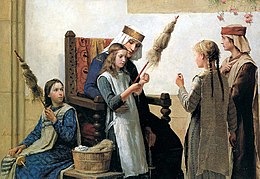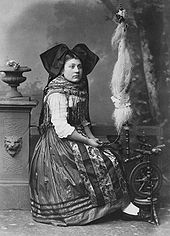Distaff


Adistaff(/ˈdɪstɑːf/,/ˈdɪstæf/,also called arock[1]) is atoolused inspinning.It is designed to hold the unspunfibers,keeping them untangled and thus easing the spinning process. It is most commonly used to holdflaxand sometimeswool,but can be used for any type of fibre. Fiber is wrapped around the distaff and tied in place with a piece of ribbon or string. The word comes from Low Germandis,meaning a bunch of flax, connected with staff.
As anadjective,the termdistaffis used to describe the female side of a family. The corresponding term for the male side of a family is the "spear" side.
Form[edit]



In Western Europe, there were two common forms of distaves, depending on the spinning method. The traditional form is a staff held under one's arm while using aspindle– see the figure illustration. It is about 3 feet (0.9 m) long, held under the left arm, with the right hand used in drawing the fibres from it.[2]This version is the older of the two, as spindle spinning predates spinning on a wheel.
A distaff can also be mounted as an attachment to aspinning wheel.On a wheel, it is placed next to thebobbin,where it is in easy reach of the spinner. This version is shorter, but otherwise does not differ from the spindle version.
By contrast, the traditionalRussiandistaff, used both with spinning wheels and with spindles, is L-shaped and consists of a horizontal board, known as thedontse(Russian:донце), and a flat vertical piece, frequently oar-shaped, to the inner side of which the bundle of fibers was tied or pinned. The spinner sat on thedontse,with the vertical piece of the distaff to her left, and drew the fibers out with her left hand. The distaff was often richly carved and painted and was an important element of Russian folk art.[3]
Recently[when?],handspinners have begun using wrist distaves to hold their fiber; these are made of flexible material, such as braided yarn, and can swing freely from the wrist. A wrist distaff generally consists of a loop with a tail, at the end of which is a tassel, often with beads on each strand. The spinner wraps therovingortowaround the tail and through the loop to keep it out of the way, and to keep it from getting snagged.
Dressing[edit]
Dressing a distaff is the act of wrapping the fiber around the distaff. With flax, the wrapping is done by laying the flax fibers down, approximately parallel to each other and the distaff, then carefully rolling the fibers onto the distaff. A ribbon or string is then tied at the top and loosely wrapped around the fibers to keep them in place.
Other meanings[edit]

The termdistaffis also used as anadjectiveto describe thematrilinealbranch of a family,[4]i.e., to the person's mother and her blood relatives. This term developed in the English-speaking communities where a distaff spinning tool was used often to symbolize domestic life.Proverbs 31cites the "wife of noble character" as one who "holds the distaff".[5]
One still-recognized use of the term is inhorse racing,in which races limited to female horses are referred to as distaff races. From 1984 until 2007, at the AmericanBreeders' Cup,the major race for fillies and mares was theBreeders' Cup Distaff.From 2008 to 2012, the event was referred to as the Breeders' Cup Ladies' Classic. Starting in 2013, the name of the race changed back toBreeders' Cup Distaff.It is commonly regarded as the female analog of the better-known Breeders' Cup Classic, though female horses are not barred from entering that race.

The phrase "on the distaff side" was commonly used by reporters covering athletic competitions when transitioning from men's events over to the highlights of women's events.
InNorse mythology,the goddessFriggspins clouds from her bejewelled distaff in the Norse constellation known as Frigg's Spinning Wheel (Friggerock,also known asOrion's belt).[6]
In popular culture[edit]
- The Women's division of the mixed-martial-arts organization EXC (Elite Xtreme Combat) is known as the "Distaff Division".
- In the video gameLoombyLucasfilm Games(1990), the Weavers' Guild, the game's equivalent towizards,and the main character, Bobbin Threadbare, usewooden stavescalled "distaffs" to control their magic, with which they "weave the very fabric of reality".[7]
See also[edit]
References[edit]
- ^"Rock."The Oxford English Dictionary.2nd ed. 1989.
- ^"Distaff."The Oxford English Dictionary.2nd ed. 1989.
- ^Украшение прялок[Distaff decoration] (in Russian). narodko.ru. 7 February 2010.Retrieved2 December2010.
- ^DistaffFree Merriam-Webster Dictionary, Retrieved on 2008-07-22
- ^Proverbs 31:19
- ^Geurber, H. A.(1909)...London: George G. Harrap & Company. p. 43 – viaWikisource.
- ^Loom's audio drama,which was provided on tape with the game

